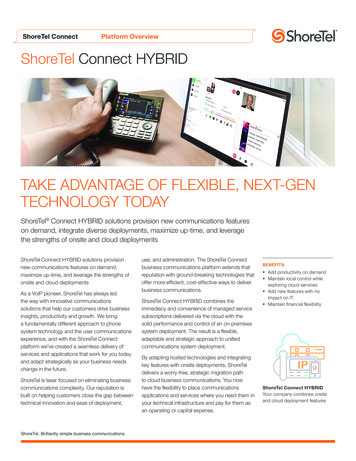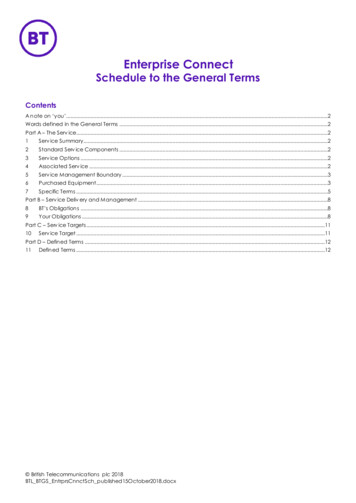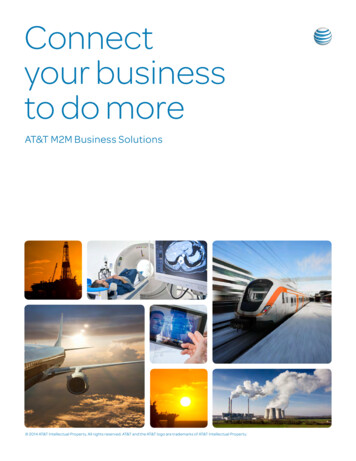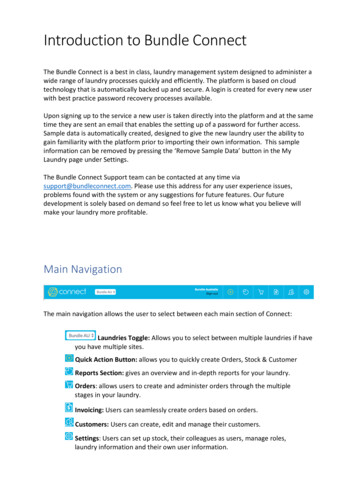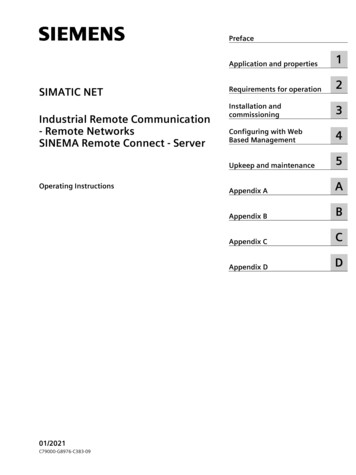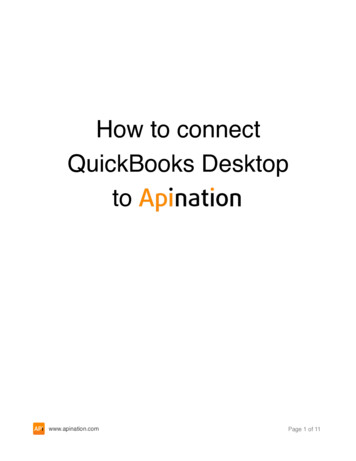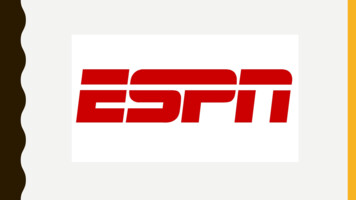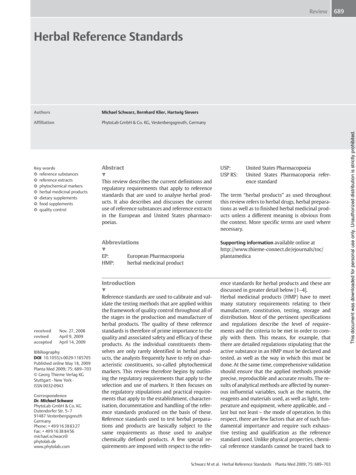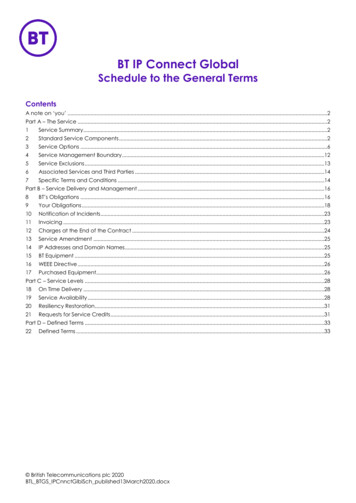
Transcription
BT IP Connect GlobalSchedule to the General TermsContentsA note on ‘you’ .2Part A – The Service .21Service Summary .22Standard Service Components .23Service Options .64Service Management Boundary .125Service Exclusions .136Associated Services and Third Parties .147Specific Terms and Conditions .14Part B – Service Delivery and Management .168BT’s Obligations .169Your Obligations .1810Notification of Incidents .2311Invoicing .2312Charges at the End of the Contract .2413Service Amendment .2514IP Addresses and Domain Names .2515BT Equipment .2516WEEE Directive .2617Purchased Equipment.26Part C – Service Levels .2818On Time Delivery .2819Service Availability .2820Resiliency Restoration .3121Requests for Service Credits .31Part D – Defined Terms .3322Defined Terms .33 British Telecommunications plc 2020BTL BTGS IPCnnctGlblSch published13March2020.docxPage 1 of 37
BT IP Connect Global ScheduleA note on ‘you’‘You’ and ‘your’ mean the Customer.Phrases that refer to ‘each of us’, ‘both of us’, ‘either one of us’, ‘either of us’ or ‘we both’ mean one or both of BT andthe Customer, whichever makes sense in the context of the sentence.Part A – The Service11.1Service SummaryBT will provide you with a private, global IP-based Virtual Private Network (“VPN”) service based on multi-protocol labelswitching (“MPLS”) technology that provides you with any-to-any connectivity and differentiated performance levels,prioritisation of delay and non-delay sensitive traffic as well as voice and multi-media applications, all on a singlenetwork and the ability to create a private, secure VPN(s) for you so that any Site within your IP VPN can directlycommunicate with any other Site in the same IP VPN, comprising:1.1.1the Standard Service Component; and1.1.2any of the Service Options that are selected by you as set out in any applicable Order,(the “Service”).1.21.3Where you select BT IP Connect Global (MPLS) under the Managed Service from BT:1.2.1Paragraph 7 of this Schedule will not apply and in such case Paragraph 7 of the Managed Service from BTSchedule to the General Terms will apply; and1.2.2Part C of this Schedule will not apply and in such case Part C of Managed Service from BT Schedule to theGeneral Terms will apply.Where you select BT IP Connect Global (MPLS) under a Managed Service:1.3.12Paragraph 7 of this Schedule will not apply and in such case Paragraph 4 of the Managed Service Schedule tothe General Terms will apply.Standard Service ComponentsBT will provide you with all of the following standard service components (“Standard Service Components”) inaccordance with the details set out in any applicable Order:2.1Access Line2.1.1BT, or BT’s agent, will arrange to connect the Site(s) to a Point of Presence (“PoP”) on the BT Network usingthe type of Access Line chosen by you and set out in the Order. The Access Line option(s) available at a Site mayvary according to the location of the Site and not all are suitable for all your applications. The Customer mayopt to Order the DSL and Ethernet (EFM) Access via the IP Connect Self Service Portal.2.1.2The Access Line options available, as further described in the rest of this Paragraph 2.1, are:2.1.3Leased Line AccessLeased Line Access is a dedicated Circuit from a Site to the nearest BT Network PoP, and is capable ofcarrying all Classes of Service (CoS).2.1.4DSL(a)If DSL is selected in the Order, BT will provide you with one of the following DSL packages, as set out inthe Order:(i)(ii)(iii)(iv)(b)(c)Business DSL Premium;Business DSL Plus;Business DSL Standard (Managed Routers are mandatory); orBasic DSL (see Paragraph 2.1.5 for further detail).The Port speed is set to the DSL speed, and traffic may burst to the Access Line speed if bandwidth isavailable. The Contention Ratio limits the typical Throughput.In some locations in the UK, DSL is supplied using 'rate adaptive' broadband technology, which does notrun at fixed speeds and is determined by the fastest speed that your analogue direct exchange line cansupport. BT will have no liability to you for failing to reach any specific speeds.BTL BTGS IPCnnctGlblSch published13March2020.docxPage 2 of 37
BT IP Connect Global Schedule(d)(e)(f)(g)(h)2.1.5Following the Service Start Date, for a period of up to 10 Business Days, BT will undertake dynamic linemanagement to stabilise the line at the most appropriate speed. During this time short outages mayoccur, which are excluded from BT’s Availability calculations.If you provide DSL Access, you are responsible for the functionality, maintenance and all Charges relatedto this access. BT will not provide DSL services if the Customer Provided Access is connected to a PBX orrelated equipment.If BT provides the DSL Local Loop Access, BT will deliver the DSL up to a defined demarcation point.Telephony services on the DSL will be disabled and the line may only be used with the Service.DSL Orders are subject to survey to determine if BT’s supplier can deliver the DSL. If the initial enquiryshows that the Service is available but is later found to be undeliverable, BT will inform you of alternativeaccess options and prices. Under this circumstance, you may order an alternative or cancel the Orderfor that Site.If this happens at either five Sites or 20 per cent of Sites (whichever is greater), then you may eitherorder alternative Access Line types or cancel the entire Order for all Sites. Under these circumstances,you will pay Charges for work already performed by BT to deliver Services to all Sites as set out in theOrder, and for termination of any Service already delivered.Basic DSL(a)In addition to the provisions set out in Paragraph 2.1.4, the following provisions apply to Basic DSL:(i)(ii)(iii)(iv)2.1.6Ethernet(a)There are three Ethernet options:(i)(ii)(iii)(b)(c)(d)Standard Ethernet Access;Ethernet Plus Access; andPremium Ethernet Access.Standard Ethernet Access has a Contention Ratio of 10:1 – 50:1 and is suitable for DE Class (inaccordance with Paragraph 2.4.2(c)).Ethernet Plus Access has a Contention Ratio 10:1 and is suitable for AF Class and DE Class (in accordancewith Paragraphs 2.4.2(b) and 2.4.2(c)).Premium Ethernet Access provides a dedicated Ethernet access Circuit connecting a Site to the BTNetwork. It is suitable for all CoS. The following limitations apply:(i)(ii)2.1.7Basic DSL is connected to the BT Network via HVPN or DSL gateways;As Basic DSL bundles are fixed, you accept there is no option to change the speeds, Class ofService values, bundled Routers or the products of the local third party supplier;Managed Routers are mandatory for all Basic DSL Sites. BT or the third party Access Line /CPEsupplier can manage the Routers; andBT will only provide BT Network reports for Basic DSL sites. BT will not provide Site to Site orRouter performance reporting as set out in Paragraph 3.1.1 of this Schedule.framing overheads will reduce IP Throughput, by an average of 9 per cent (depending on CoSprofile and average packet size) of the “headline” access speed; andmaximum EF Class traffic (in accordance with Paragraph 2.4.2(a)) is 50 per cent of Port speed.HVPN(a)(b)(c)(d)HVPN requires the use of Managed Routers. An IPsec Tunnel is created from a Managed Router at a Siteto a secure network gateway to the BT Network. You may access its VPN at the HVPN Port speed as setout in the Order.You may either provide your own broadband (“Customer Provided Access” or “CPA”), or BT may providethe broadband (“BT Provided Access”). For CPA, you will provide an ISP-supplied modem at your ownexpense. Both the upstream and downstream broadband speed must be greater than, or equal to, theHVPN Port speed.For new Orders at a Site, one Managed Router is required. If you replace an existing access method withHVPN, it may be necessary either to replace an existing Managed Router, or to add an additionalManaged Router, for which you agree to pay, and to pay for any installation and De-installation Charges.The Split Tunnelling feature includes two related capabilities:(i)IBO – IBO will provide a way for you to give restricted access to the Internet from the VPN sitevia the HVPN CPE. The Internet traffic is presented on your LAN Port, and the CPE will route theBTL BTGS IPCnnctGlblSch published13March2020.docxPage 3 of 37
BT IP Connect Global Schedule(ii)(e)2.1.8Both features provide security against intrusion from the Internet via a zone-based firewall.BT Reach-In NNI(a)(b)(c)(d)BT Reach-In NNI is a private, in-country IP-based VPN service delivered over a third party network thatextends the reach of your IP Connect Global network.The BT Network is interconnected with BT’s suppliers’ networks in certain countries. You may access itsMPLS network via BT’s supplier’s IP VPN service via these interconnections.BT Reach-In NNI consists of an Access Line, CoS, Port(s) and either Unmanaged BT Routers, UnmanagedCustomer Routers, or Managed Router(s) at each Site. You may order different configurations to providethe required level of resilience at the Site.BT will provide the Access Line from the Site to a Port on a node in BT’s supplier’s network using one ofthe following, as set out in the Order:(i)(ii)(iii)(iv)(e)2.1.9Leased Line;Premium Ethernet;Business DSL Premium; orBasic DSL.Managed Routers, Unmanaged BT Routers and Unmanaged Customer Routers connected to BT’ssupplier’s network must conform to the CoS markings and classes available on BT’s supplier’s network.Managed Routers will perform CoS mapping and re-mark traffic from BT’s standard six CoS (on the LANside of the Managed Router) to the supplier-specific CoS. Customer Data will not be re-marked as ittransits your supplier’s network.Fast Turn-up Service(a)(b)The Fast Turn-up Service enables you to connect a Site(s) to the BT Network through the rapiddeployment of a Gateway Device with access from a Site. This rapid deployment and configurationmeans it is useful for providing temporary connectivity to a Site.The Fast Turn-up Service consists of the following service standard components in the configuration, asset out in the Order.(i)(ii)(iii)(iv)(v)2.1.10Internet traffic onto the HVPN access without encryption so that the Internet traffic does nottraverse the IPSec Tunnel; andiLAN – iLAN provides an additional Port with unrestricted Internet access. The iLAN is typicallyused for a guest LAN or Wi-Fi access to the Internet. There is no access to the VPN from the iLANPort. iLAN allows you to provide internet access without the cost of additional hardware.Mobile Service Managed Gateway Device – Gateway Devices are sold to you in accordance withthe provisions of Paragraph 15.5 of this Schedule. Hardware and associated software located ata Site that provides 10/100Mb Ethernet presentation to your remote LAN and transmits andreceives mobile data signals via GPRS, 3G or other data transmission standards using a mobilenetwork (“Gateway Device”).SIM Card – BT will allocate a number to the SIMs for use in the Gateway Device. The numbersbelong to BT and may only be transferred to another ISP with our consent and in accordance withprevailing industry rules and processes.Backhaul network – A VPN connection over the BT Network which enables your data traffic totransit from the mobile network to your existing Service.Service reconfiguration – In order to provide the Fast Turn-up Service, BT will need to reconfigureyour existing Service to enable the Fast Turn-up Service to interconnect with your existing IPConnect Global VPN service.Antenna – An ancillary device that is positioned remotely from the Gateway Device which mayimprove the mobile signal.VSAT(a)(b)VSAT access enables you to connect a Site to the BT Network. VSAT access is delivered using OSI Layer2 technology over satellite technology. The BT Purchased Equipment at your Site(s) will be connectedto Earth Stations, which will be onward connected to the BT Network.VSAT access consists of the following service standard components, as set out in the Order.BTL BTGS IPCnnctGlblSch published13March2020.docxPage 4 of 37
BT IP Connect Global Schedule(i)(ii)(iii)(iv)(c)BT Purchased Equipment in the form of Satellite Modems and Antennas. You will ensure anyequipment is protected against damage due to over voltage, surges, and extreme environmentalconditions;Cabling will be provided between the Antenna and BT Purchased Equipment;Satellite specific licences allowing operation of the VSAT access at your Site. . In some countriesyou will be required to apply for these licences. BT will assist you to obtain these licences in thosecountries where you’re required to apply for the licence; andA Site survey to determine if your Site is suitable for VSAT access. You will pay for the Site surveyCharges regardless of whether you decide not to proceed with the VSAT access.BT will provide you with any of the following VSAT access options in accordance with the details set outin the Order:(i)(ii)(iii)Premium VSAT Access with a Contention Ratio of 1:1. This option is suitable for all CoS.Plus VSAT Access with a Contention Ratio of 4:1. This option is suitable for AF Class and DE Class.Standard VSAT Access with a Contention Ratio of 10:1. This option is suitable for DE Class.2.2You may opt for Customer Provided Access or BT Provided Access. If you opt for Customer Provided Access BT willprovide you with an ISP-supplied modem or a data SIM for mobile connection, at your own expense.2.3Port2.42.3.1Where BT manages the CPE for the Service, a part of the bandwidth you have contracted for is used by BT formanagement purposes.2.3.2If the Access Line speed exceeds the Port speed, traffic shaping is used to limit the use of Access Line capacityto the Port speed.2.3.3For BT Reach-In NNI, the Port is the point on BT’s supplier’s network where the Access Line is connected to BT’ssupplier’s IP VPN service.Class of Service (“CoS”)2.4.1CoS assists with congestion avoidance and management. BT’s traffic may be either “In-Contract” or “Out-ofContract”. In-Contract traffic is data sent by you within the configuration rules applied by BT and is supportedby the Service Levels set out in Part C of this Schedule. Out-of-Contract traffic is data sent by you outside of theconfiguration rules applied by BT and is not supported by the Service Levels set out in Part C of this Schedule.2.4.2The Service has three types of application CoS (EF Class, AF Class and DE Class – as set out in Paragraphs 2.4.2(a),2.4.2(b) and 2.4.2(c)). You may order up to four separate AF Classes, as well as one of each DE Class and EFClass - up to six Classes in total. CoS varies based on application type and speed, but the Access Line and thePort must have the same or greater bandwidth than the total contracted rate per CoS, (the contracted rate foreach AF Class is counted separately). Your applications mapping policy to the appropriate CoS, based on theapplications operating across your VPN, is set in consultation with BT. Any traffic not identified as part of asubscribed CoS is marked DE Class. The prioritisation of data within the Service is set out below:(a)(b)(c)“EF Class” is for voice over IP applications. You will specify the amount of EF Class traffic “In-Contractrate” required. There is no bursting capability for EF Class traffic and any traffic above the In-Contractrate is dropped.“AF Class” is for delay-sensitive data traffic. You specify the amount of AF Class traffic (“In-Contract”bandwidth). Traffic may burst above the In-Contract rate if bandwidth is available (“Out-of-Contract”traffic). The assured Throughput for each AF Class is the In-Contract bandwidth for that CoS. Traffic inexcess of the In-Contract bandwidth in any AF Class is marked Out-of-Contract.“DE Clas
(b) You may either provide your own broadband (“Customer Provided Access ”or CPA), or BT may provide the broadband (“BT Provided Access”). For CPA, you will provide an ISP-supplied modem at your own expense. Both the upstream and downstream broadband spee
